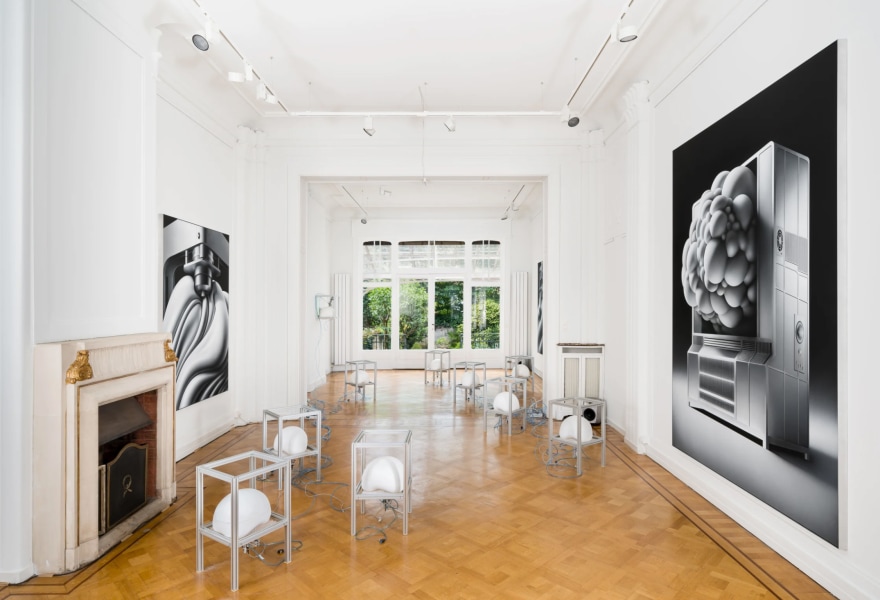22 july 2024, Yves Joris
Sophisticated decay, humans and technology in the work of Harrison Pearce
The cool mechanical factory sounds contrast starkly with the majestic environment in which they resonate. To be honest, I feel a bit uneasy. Usually, I am welcomed here by canvases with bright colours and explosions of figurative talent. But now, I fear the explosion will come from the bewildering devices manifesting in the exhibition space of the GNYP Gallery. But nothing is what it seems and my interest in the surrounding art quickly grows.
The exhibition Graceful Degradation with work by Harrison Pearce is a fascinating exploration of the symbiosis between organic forms and mechanical components. It combines striking images, sound installations and conceptual artworks that reflect on the influence of technology on our understanding of reality and the boundaries between body and mind. Below, I take a closer look at the concept of 'graceful degradation' that is central to Pearce's work.
Harrison Pearce is a British artist who lives and works in London and is known for his multidisciplinary approach to art, often combining sculpture, installation and sound. Pearce has a background in philosophy and his work reflects a profound interest in the overlap between technology, science and humanity. He has exhibited in renowned galleries and institutions worldwide and his work is included in several important art collections.

Harrison Pearce, Graceful Degradation, GNYP Gallery
Failure is no option
‘Graceful degradation’ is a term originating from information technology and refers to a system's ability to deteriorate gradually rather than fail suddenly. Harrison Pearce translates this concept into art through sculptures and installations that explore the fragile balance between the human and the mechanical. His work reflects on how technology permeates and transforms our lives, raising questions about its implications on our physical and mental integrity.
On entering the exhibition, visitors are welcomed by an intriguing interplay of sound and image. Pearce's works are often large in scale and combine elements that feel both organic and mechanical. These hybrid forms create a tension between the familiar and the unknown, the natural and the artificial.
A central work in the exhibition is a kinetic sculpture that responds to the presence of spectators. The machine's movement is both elegant and unsettling. The sculpture seems to breathe, to live, yet it is clearly a product of human ingenuity and technological advancement. This work forces the viewer to think about how dependent we have become on technology and how this dependency changes us.

Harrison Pearce, Graceful Degradation, GNYP Gallery
Searching for a new interpretation
'Graceful degradation' in the context of this exhibition refers not only to the technical definition, but also to a philosophical understanding of decay and transformation. Pearce examines how systems—both biological and technological—deal with errors and aging. Instead of failing abruptly, these systems exhibit a gradual decline that can be both beautiful and tragic.
This idea is further explored in a series of works that delve into medical technology and brain disorders. Pearce draws from personal experience, adding an extra layer of authenticity and urgency to his art. The work highlights the vulnerability of the human body and the role of technology in extending and improving life, as well as the ethical questions accompanying this.
Another important aspect of Graceful Degradation is how it influences our perception of reality. Through technology, our senses and cognitive processes are altered, leading to a new interpretation of reality. This theme is visually translated into work on canvas that explores light and shadow, distortion and reflection, creating a sense of confusion and awe.
Symbiosis of human and machine
The exhibition invites us to reflect on the increasingly intimate relationship between humans and machinery. It raises questions about the sustainability of our technological progress and its impact on our identity and society. His artwork serves as a mirror in which we can see our own dependency on technology and the potential future scenarios this dependency may bring.
The subtle beauty of Pearce's work lies in its ability to convey complex ideas in an accessible and visually appealing way. It invites contemplation and discussion and does not provide simple answers, but instead stimulates a deeper exploration of the human condition in the technological era.
I can only conclude that my initial impression was wrong. Graceful Degradation is more than an exhibition; it is a philosophical exploration of the boundaries of the human and the mechanical. Harrison Pearce succeeds in challenging and inspiring us with his unique approach to art and technology. His work reminds us of the necessity to critically think about the role of technology in our lives and the subtle yet profound changes it brings about.

Harrison Pearce, Graceful Degradation, GNYP Gallery
